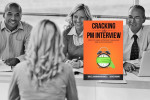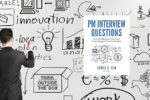Great answers to product management interview questions

Decode and Conquer: Answers to Product Management Interviews by Lewis C. Lin
Lewis C. Lin‘s book is an inventory of product management interview questions and answers. Lin includes tips for each category of question and gives specific responses and guidance. Like Cracking the PM Interview, this book includes practice questions and frameworks for confidently answering interview questions and understanding the goal of each question.
Types of product management interview questions
Lin covers design questions very thoroughly–there are sections on designing web interfaces, mobile applications, consumer products, and services. He provides good answers along with bad ones–the answers are graded at the end of each section. Additionally, there are sections on technical questions, estimation, pricing, metrics. Lin includes three flavors of strategy questions: making trade-offs, new market entry, “you’re the CEO”, and creating vision. The final sections provide advice on stress questions and behavioral interviews. After reading this book, there will be few surprises in a product management interview.
The book is heavily weighted towards on-line software and high tech products. Product managers in consumer products, hardware, services, or packaged/on-premise software may not find 100% relevant material here.
Design critiques
“How would you improve our product?” This common product management interview question is meant to test your ability to propose impactful changes to an existing product. Weak answers will either be one obvious improvement or a rambling set of changes which do not move any metrics. A strong answer starts with identifying the goals of the product and the target customers. A key metric or metrics should be identified by which to measure the improvement. From there, a set of use cases can be identified which will lead to a set of alternatives for product improvements. An important skill to demonstrate when answering this question is the ability to prioritize. From the set of possible personas, use cases, and improvements, select the ones that most closely meet the goals and metrics identified at the outset. Presenting several alternatives at each level is a great opportunity to show creativity and your ability to think outside the box. In some cases, linking to product strategy will be critical to providing an on target answer. Answering this question without building the links between strategy, business metrics, and user needs will result in a random response that will likely miss the mark.
Design questions
“How would you design a to do list?” Product design questions test the applicant’s ability to think on their feet and create a full product or feature. New product design questions can be very high level (“design a lamp”). Start with identifying the goal of the product–if the interviewer won’t tell you, state your assumptions so that you have something to build on. Decide which metric or business driver you will impact most. From there, identify the possible users for the new product or feature. Select the one that seems most relevant. You won’t have time to cover everything in the answer. Once the user is selected, move on to use cases, goals, and scenarios for that user. The use cases should naturally result in a set of features for your new product. Prioritize these and close by linking back to the goal of the product, the business strategy, and the user needs you are meeting. Show you aren’t afraid to color outside the box by including a range of features in the product or tackle a novel problem. Present a range of ideas ranging from mundane to outlandish and demonstrate that you can generate a broad range of ideas and decide among them quickly.
Metrics questions
To answer questions about SaaS product metrics, a useful framework to structure your answer with is some variation of Dave McClure’s Startup Metrics for Pirates: AARRR!. They metrics are: Acquisition, Activation, Retention, Referral, and Revenue. You can view these as a funnel or consider them separately in your answer. Even with A/B testing, there will be tradeoffs to make–one metric will go up while another will go down. Ensure your answer aligns with whatever strategic assumptions you state.
Also consider a model like Eric Ries’ Engines of Growth: paid, viral, and sticky.
For SaaS companies, read this analysis of Box’s financial metrics by Tien Tzuo, CEO of Zuora and The Challenges SaaS Companies Face Communicating Their Financial Health by Tom Tunguz.
Focusing on business levers and metrics shows you know how to drive the business and aren’t lost in the weeds of daily product management execution concerns. Making decisions is a key skill for product managers and being out of touch with what makes your company revenues flow is just as lethal as being out of touch with your customers.
Pricing questions
“How would you determine the price for piece of wearable technology?” For a pricing question, Lin suggests triangulating between the customer’s willingness to pay, competitive pricing, and cost-based pricing. Understanding the cost structure is a good basis, but won’t get you all the way to the answer. Consider what alternatives the customer has and what type of demand and supply dynamics there are in the market. If you are targeting a heavily business-oriented product management role, you will need to have pricing frameworks in you back pocket so that you are not a deer in the headlights at the whiteboard.
Strategy questions
“You are the CEO of Research In Motion. What would you do?” Strategy questions require that you put aside product-level considerations and focus on the business and available market opportunities. This type of question is frequently amenable to a diagnostic approach which begins with an assessment of the current state, identifies gaps, and proposes a future state solution. A Strengths, Weaknesses, Opportunities, Threats analysis can be a good place to start. Focusing on financial metrics and broad market needs (versus individual user needs) will enable you to uplevel your answers. Competition and partnerships come into play more prominently in strategy questions than they may in product questions. A CEO will not be thinking of individual products and perhaps not even product lines. Overall company value proposition and market segment needs will be the right level to consider for this question.
“How would facebook enter the mobile handset market?” This is a common variation of the strategy question. Case study questions can be tricky. To prepare, research the market that your target company is in, as well as adjacent markets and competitors. Review recent tech business stories and analysis to understand current business strategies in play and what issues tech leaders are grappling with. If you are caught off-guard, you will at least have some analogs you can draw upon. Like the product design questions, start your answer with stating your assumptions about the current business strategy and goals of the company in question. Common case study questions involve new market entry–Michael Porter’s Five Forces framework can be a good starting point. Discuss how the new market or segment fits with the company’s core business and complementary business opportunities. Understanding the company’s underlying value proposition can help put a seemingly unrelated business opportunity into context.
Get familiar with metrics (number of iPhones, iPads, Xboxes, copies of Windows, facebook users, LinkedIn users, revenues of major companies) that are relevant to the company you are targeting. Get an analyst report on the market, or at least skim an overview like Mary Meeker’s Internet Trends report to be knowledgeable about industry trends and major events.
If you are preparing for an interview, this is a great book to help get your head in the game. The questions are posed as a group before revealing the answer so you can practice and then review against Lin’s responses. Check out the quick visual re-cap of the book.
Here’s Lin talking about how to answer odd interview questions:
In this video, Jason Shah gives his take on product management interviews:







Olaf,
Thanks for writing up a thoughtful review of Decode and Conquer. If your readers are looking for an easy way to prepare for the PM interview, check out this one-page PM interview cheat sheet, based on the book: http://www.impactinterview.com/2014/01/the-ultimate-product-manager-interview-cheat-sheet/
Thanks again, and good luck all on your PM interviews:
– Lewis C. Lin, Author of Decode and Conquer